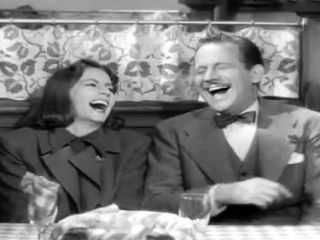


Cup of coffee without cream Ninotchka 1939

Fabulous European Vacation 1985

with Humphrey Bogart as Charlie Allnut (won his only Academy Award) and Katharine Hepburn as Rose Sayer, from The African Queen 1951 film directed by John Huston.
 CHARLIE ALLNUT: How'd you like a nice cup of tea?
ROSE SAYER: I'd like a cup of tea.
CHARLIE ALLNUT: It'll taste a little rusty, but we can't have everything, can we? There you are. Get this out of the way. Sugar, miss?
ROSE SAYER: Thank you.
CHARLIE ALLNUT: Don't mention it. A bit of supper, miss?
CHARLIE ALLNUT: How'd you like a nice cup of tea?
ROSE SAYER: I'd like a cup of tea.
CHARLIE ALLNUT: It'll taste a little rusty, but we can't have everything, can we? There you are. Get this out of the way. Sugar, miss?
ROSE SAYER: Thank you.
CHARLIE ALLNUT: Don't mention it. A bit of supper, miss?
 ROSE SAYER: It's too hot to eat.
CHARLIE ALLNUT: How long you been out here, miss?
ROSE SAYER: About 10 years.
CHARLIE ALLNUT: What part of England are you from?
ROSE SAYER: The Midlands.
CHARLIE ALLNUT: Sounds pretty, anyway.
ROSE SAYER: Yes, it is. It's very pretty.
CHARLIE ALLNUT: Ever get homesick?
ROSE SAYER: It's Sunday afternoons I think of most, the peace and the quiet.
CHARLIE ALLNUT: Yeah, on Sunday afternoons, I was always sleepin' one off.
ROSE SAYER: This is very, very good.
CHARLIE ALLNUT: Yes, it isn't half bad, is it?
ROSE SAYER: What brought you to Africa, Mr Allnut?
CHARLIE ALLNUT: The Zambezi bridge. A whole boatload of us Canucks came to work on it. Don't know why they wanted it, both sides of the river the same, but why does a chicken cross the road?
ROSE SAYER: I beg your pardon?
CHARLIE ALLNUT: Guess you never saw me without whiskers and cleaned up. I'll bet you wouldn't recognise me, that much of a change. Dressed up, too. If I only had some clean clothes like you. Now, you... Why, you could be at high tea. Say, that's an idea, miss. How's about a nice little cup of tea? Don't you stir. I'll be glad to make it for you. How's the book, miss?
ROSE SAYER: I'm sorry I poured that gin out, Charlie.
CHARLIE ALLNUT: Aw, forget it, Rosie. Just to show there's no hard feelings, I'll make you another cup of tea.
ROSE SAYER: Oh.
CHARLIE ALLNUT: You carry on more over a cup of tea than I do over a glass of gin.
ROSE SAYER: It's too hot to eat.
CHARLIE ALLNUT: How long you been out here, miss?
ROSE SAYER: About 10 years.
CHARLIE ALLNUT: What part of England are you from?
ROSE SAYER: The Midlands.
CHARLIE ALLNUT: Sounds pretty, anyway.
ROSE SAYER: Yes, it is. It's very pretty.
CHARLIE ALLNUT: Ever get homesick?
ROSE SAYER: It's Sunday afternoons I think of most, the peace and the quiet.
CHARLIE ALLNUT: Yeah, on Sunday afternoons, I was always sleepin' one off.
ROSE SAYER: This is very, very good.
CHARLIE ALLNUT: Yes, it isn't half bad, is it?
ROSE SAYER: What brought you to Africa, Mr Allnut?
CHARLIE ALLNUT: The Zambezi bridge. A whole boatload of us Canucks came to work on it. Don't know why they wanted it, both sides of the river the same, but why does a chicken cross the road?
ROSE SAYER: I beg your pardon?
CHARLIE ALLNUT: Guess you never saw me without whiskers and cleaned up. I'll bet you wouldn't recognise me, that much of a change. Dressed up, too. If I only had some clean clothes like you. Now, you... Why, you could be at high tea. Say, that's an idea, miss. How's about a nice little cup of tea? Don't you stir. I'll be glad to make it for you. How's the book, miss?
ROSE SAYER: I'm sorry I poured that gin out, Charlie.
CHARLIE ALLNUT: Aw, forget it, Rosie. Just to show there's no hard feelings, I'll make you another cup of tea.
ROSE SAYER: Oh.
CHARLIE ALLNUT: You carry on more over a cup of tea than I do over a glass of gin.








The two no.1 AFI's "The 50 greatest american screen legends" for this film were paid as follows: Bogart $125,000 + 30% of gross; Hepburn $130,000 + 10% of profits.
The boat used as the African Queen is actually the 35-foot L.S. Livingston, which had been a working diesel boat for 40 years; the steam engine was a prop and the real diesel engine was hidden under stacked crates of gin and other cargo. Florida attorney and Humphrey Bogart enthusiast Jim Hendricks Sr. purchased the boat in 1982 in Key Largo, Florida.
Scenes on the boat were filmed using a large raft with a mockup of the boat on top. Sections of the boat set could be removed to make room for the large Technicolor camera. This proved hazardous on one occasion when the boat's boiler, a heavy copper replica, almost fell on Katharine Hepburn; it was not secured to the deck because it also had to be moved to accommodate the camera.
The African Queen opened on December 26, 1951, at the Fox Wilshire Theatre in Beverly Hills in time to qualify for the 24th Academy Awards. The film opened in New York City on February 20, 1952, at the Capitol Theatre.
Much of the film was shot on location in Uganda and the Congo in Africa. Humphrey Bogart later bragged that he and Huston were the only members of the cast and crew who escaped illness, which he credited to having drunk whiskey on location rather than the local water.
About half of the film was shot in the UK; the scenes in which Bogart and Hepburn are seen in the water were all shot in studio tanks at Isleworth Studios, Middlesex. These scenes were considered too dangerous to shoot in Africa.